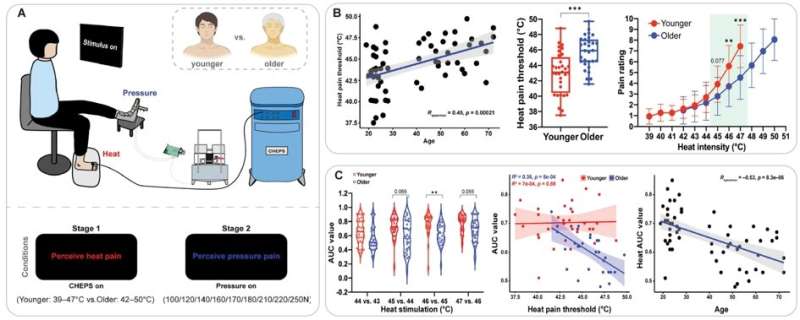This article has been reviewed according to Science X's editorial process and policies. Editors have highlighted the following attributes while ensuring the content's credibility:
fact-checked
peer-reviewed publication
trusted source
proofread
Study finds heat pain perception decreases with age

Does pain perception change with age? In particular, is there a significant increase or decrease in perception between older and younger people in response to different types of painful stimuli, such as heat and pressure?
Pain perception is a complex physiological and psychological process that is influenced by various factors, including age, gender, cultural background, and previous pain experience. With the accelerated aging of the population, understanding how age affects pain perception and how these changes occur is critical for developing appropriate pain management strategies for older adults.
To reveal the behavioral pattern underlying the changes in pain perception during aging and to provide a scientific basis for pain management and treatment in older adults, Dr. Kong Yazhuo and his team from the Institute of Psychology of the Chinese Academy of Sciences compared the similarities and differences in the perception of two different modalities of stimuli, heat and pressure, between young and older adults by collecting sensory debriefings of these stimuli from young adults and older adults.
The findings are published in the journal Age and Ageing in a paper titled "Age-associated changes in multimodal pain perception."
The researchers designed involved applying heat and pressure stimuli that relied on small and large fibers, respectively, to groups of younger and older adults. Participants' pain thresholds and ratings of stimulus sensation were assessed by heat and pressure pulses of nine intensities applied to their right and left feet separately.
They found that older adults reported lower pain ratings for heat stimuli above their pain threshold, suggesting a reduced sensitivity to heat pain with age.
In addition, older adults had significantly lower discriminative ability for heat stimuli near or above their pain threshold compared to younger adults, suggesting a decline in the ability to discriminate heat pain intensity with age. However, no significant decline was observed for pressure pain.
The researchers concluded that aging is associated with a decline in heat pain perception, as evidenced by increased thresholds and decrease discriminability. Interestingly, pressure pain perception and sensitivity do not show significant age-related changes.
These findings increase our understanding of how aging affects somatosensory function, which could inform the assessment and treatment of older adults experiencing pain.
More information: Yongkang Zhi et al, Age-associated changes in multimodal pain perception, Age and Ageing (2024). DOI: 10.1093/ageing/afae107

















